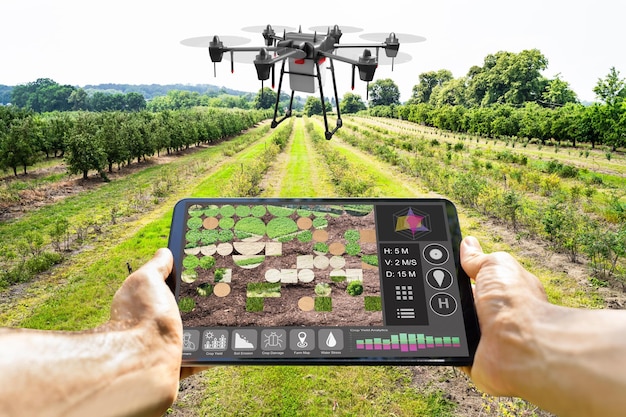Latest US Government Incentives for Agricultural Robotics Adoption

The latest government incentives for adopting agricultural robotics in the US include grants, tax credits, and pilot programs aimed at improving efficiency, sustainability, and labor management in the agricultural sector.
Discover the newest government incentives for adopting agricultural robotics in the US, designed to help farmers integrate cutting-edge technology, enhance productivity, and promote sustainable farming practices.
Understanding Government Incentives for Agricultural Robotics
Government incentives play a crucial role in encouraging the adoption of new technologies within the agricultural sector. These incentives are designed to help farmers overcome financial barriers and embrace innovations that can improve efficiency, sustainability, and overall productivity.
By understanding the types of incentives available and how to access them, farmers can make informed decisions about integrating agricultural robotics into their operations. This, in turn, contributes to the modernization and resilience of the US agricultural industry.

Types of Government Incentives
The US government offers a variety of incentives to promote the adoption of agricultural robotics. These can be broadly categorized into grants, tax credits, and pilot programs.
- Grants: These are typically awarded to farmers for specific projects aimed at implementing new technologies or improving existing farming practices. Grants can cover a portion of the costs associated with purchasing and integrating agricultural robots.
- Tax Credits: Tax credits reduce the amount of income tax a farmer owes. They can be claimed for investments in agricultural robotics, providing a financial benefit that encourages adoption.
- Pilot Programs: Pilot programs are initiatives designed to test the feasibility and effectiveness of new technologies and farming practices. Participating in these programs can provide farmers with access to funding, technical support, and valuable data on the performance of agricultural robots.
Each type of incentive has its own eligibility requirements and application process. Farmers should carefully research the available options to determine which ones are the best fit for their operations.
In summary, government incentives are an essential tool for promoting the adoption of agricultural robotics. By providing financial support and technical assistance, these incentives help farmers overcome barriers to entry and embrace technologies that can transform their operations.
Recent Legislative Changes Supporting Ag Robotics
Recent legislative changes have significantly impacted the landscape of government incentives for agricultural robotics. These changes reflect a growing recognition of the importance of technology in addressing challenges such as labor shortages, environmental sustainability, and food security.
Understanding these legislative updates is crucial for farmers looking to take advantage of the latest incentives and programs. Here, we delve into some of the key legislative changes and their implications for the adoption of agricultural robotics.
Key Legislative Updates
Several pieces of legislation have been introduced or amended in recent years to support the adoption of agricultural robotics. These include:
- The Farm Bill: The Farm Bill, reauthorized every five years, includes provisions that support agricultural research, technology development, and conservation practices. Recent versions of the Farm Bill have increased funding for programs that promote the adoption of precision agriculture technologies, including robotics.
- The Inflation Reduction Act: This act includes significant investments in clean energy and climate resilience, with provisions that could benefit farmers adopting sustainable farming practices using agricultural robotics. Tax credits and grants are available for investments in technologies that reduce greenhouse gas emissions and improve energy efficiency.
- State-Level Legislation: Many states have also introduced their own incentives and programs to support the adoption of agricultural robotics. These can include tax credits, grants, and pilot programs tailored to the specific needs of local farmers.
These legislative changes reflect a growing commitment to supporting innovation in agriculture and promoting the adoption of technologies that can improve productivity and sustainability. Farmers should stay informed about these updates and explore opportunities to leverage them to their advantage.
In conclusion, recent legislative changes have created a more favorable environment for the adoption of agricultural robotics. By understanding these changes and their implications, farmers can access the resources and support they need to integrate these technologies into their operations.

Federal Grant Programs for Agricultural Robotics
Federal grant programs are a significant source of funding for farmers looking to invest in agricultural robotics. These programs provide financial assistance for projects aimed at implementing new technologies, improving farming practices, and promoting sustainable agriculture.
Here, we explore some of the key federal grant programs that support the adoption of agricultural robotics, outlining their eligibility requirements, funding levels, and application processes.
Notable Federal Grant Programs
Several federal agencies offer grant programs that can be used to fund the purchase and integration of agricultural robots. These include:
- USDA’s Rural Energy for America Program (REAP): REAP provides grants and loans to agricultural producers and rural small businesses for renewable energy systems and energy efficiency improvements. Agricultural robots that reduce energy consumption or utilize renewable energy sources may be eligible for funding under this program.
- National Institute of Food and Agriculture (NIFA) Grants: NIFA offers a variety of grants for research, education, and extension projects related to agriculture. These grants can support projects that develop and evaluate new agricultural robotics technologies or promote their adoption among farmers.
- Small Business Innovation Research (SBIR) Program: The SBIR program provides funding for small businesses to conduct research and development on innovative technologies. Agricultural robotics companies can apply for SBIR grants to develop and commercialize new products.
To apply for these grant programs, farmers must submit a detailed proposal outlining their project goals, budget, and expected outcomes. The application process can be competitive, so it is important to carefully review the eligibility requirements and prepare a well-written and compelling proposal.
In summary, federal grant programs offer valuable financial support for farmers looking to invest in agricultural robotics. By understanding the available programs and preparing strong applications, farmers can increase their chances of securing funding and implementing these technologies on their farms.
State-Level Initiatives Boosting Robotics Adoption
In addition to federal programs, many states have implemented their own initiatives to boost the adoption of agricultural robotics. These state-level initiatives are often tailored to the specific needs and priorities of local farmers, providing targeted support and resources.
Here, we explore some examples of state-level programs that are driving the adoption of agricultural robotics, highlighting their unique features and benefits.
Examples of State Initiatives
Several states have taken proactive steps to support the adoption of agricultural robotics, including:
- California: California offers tax credits and grants for farmers who invest in technologies that reduce water consumption and improve air quality. Agricultural robots that automate irrigation or reduce pesticide use may be eligible for these incentives.
- Texas: Texas has established several research and development centers focused on agricultural technology. These centers provide resources and expertise to help farmers integrate new technologies, including robotics, into their operations.
- Florida: Florida offers grants for farmers who implement best management practices for water and nutrient management. Agricultural robots that can precisely apply fertilizers or monitor soil moisture may be eligible for these grants.
These state-level initiatives reflect a growing recognition of the importance of technology in addressing the challenges facing farmers. By providing targeted support and resources, these programs are helping farmers embrace agricultural robotics and improve their productivity and sustainability.
In conclusion, state-level initiatives are playing a crucial role in boosting the adoption of agricultural robotics. By understanding the programs available in their state, farmers can access the resources and support they need to integrate these technologies into their operations.
Tax Credits and Deductions for Ag Robotics Investments
Tax credits and deductions offer another important avenue for farmers to recoup the costs of investing in agricultural robotics. These incentives reduce the amount of income tax a farmer owes, providing a direct financial benefit.
Here, we delve into the tax credits and deductions that are available for investments in agricultural robotics, outlining their eligibility requirements and how to claim them.
Available Tax Incentives
Several federal and state tax incentives can be used to offset the costs of investing in agricultural robotics. These include:
- Section 179 Deduction: Section 179 of the IRS tax code allows farmers to deduct the full purchase price of eligible equipment, including agricultural robots, in the year it is placed in service. This can provide a significant tax benefit for farmers who invest in new technology.
- Bonus Depreciation: Bonus depreciation allows farmers to deduct a percentage of the cost of new equipment, including agricultural robots, in the first year of service. This can be combined with the Section 179 deduction to provide even greater tax savings.
- State Tax Credits: Many states offer their own tax credits for investments in agricultural technology. These credits can be claimed in addition to federal tax incentives, providing further financial benefits.
To claim these tax incentives, farmers must keep accurate records of their investments and consult with a tax professional to ensure they are meeting all eligibility requirements. The tax benefits can be substantial, making it well worth the effort to explore these options.
In summary, tax credits and deductions offer a valuable way for farmers to reduce the costs of investing in agricultural robotics. By understanding the available incentives and how to claim them, farmers can maximize their financial benefits and accelerate the adoption of these technologies.
Pilot Programs and Demonstrations: Learning and Earning
Pilot programs and demonstrations provide farmers with opportunities to test and evaluate agricultural robotics technologies in real-world settings. These programs offer a low-risk way to learn about the potential benefits of robotics and make informed decisions about adoption.
Here, we explore the role of pilot programs and demonstrations in promoting the adoption of agricultural robotics, highlighting their key features and benefits.
Benefits of Pilot Programs
Participating in pilot programs can provide farmers with several advantages, including:
- Access to Funding: Many pilot programs provide funding to participating farmers to cover the costs of purchasing and operating agricultural robots.
- Technical Support: Pilot programs often provide technical support and training to help farmers integrate new technologies into their operations.
- Data Collection and Analysis: Pilot programs typically involve data collection and analysis to evaluate the performance of agricultural robots. This data can provide valuable insights into the potential benefits of adoption.
By participating in pilot programs, farmers can gain firsthand experience with agricultural robotics and learn whether these technologies are a good fit for their operations. This can help them make more informed decisions about investing in robotics and avoid costly mistakes.
In conclusion, pilot programs and demonstrations play a vital role in promoting the adoption of agricultural robotics. By providing farmers with opportunities to test and evaluate new technologies, these programs help them make informed decisions and accelerate the integration of robotics into their operations.
| Key Point | Brief Description |
|---|---|
| 💰 Federal Grants | USDA & NIFA offer funding for robotics adoption. |
| 🚜 State Initiatives | California, Texas, & Florida have tailored programs. |
| 🧾 Tax Credits | Section 179 & bonus depreciation reduce tax burdens. |
| 🧪 Pilot Programs | Test robotics with funding & expert support. |
Frequently Asked Questions
▼
Robots for harvesting, planting, weeding, spraying, and monitoring crops are often eligible, provided they meet specific energy efficiency or environmental benefit criteria set by the granting agency.
▼
Check your state’s Department of Agriculture website or contact your local extension office. They often have detailed information on state-specific programs and incentives.
▼
Yes, many incentives are specifically tailored for small-scale farmers, including grants and cost-sharing programs that help offset the initial investment in agricultural robotics.
▼
Generally, you’ll need a detailed project proposal, budget, and information about your farm’s operations. Proof of purchase and compliance with environmental regulations may also be required.
▼
Government incentives can change frequently due to evolving legislation and budget allocations. It’s crucial to stay updated by regularly checking official government websites and agricultural publications.
Conclusion
Navigating the landscape of government incentives for agricultural robotics in the US can seem daunting, but understanding the available options can significantly ease the financial burden of adopting these technologies. By exploring federal and state grant programs, tax credits, and pilot programs, farmers can unlock opportunities to enhance productivity, sustainability, and overall farm efficiency.





